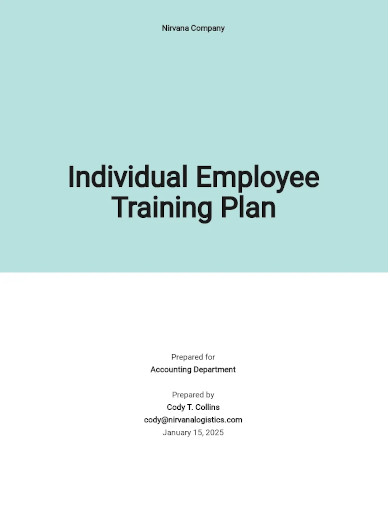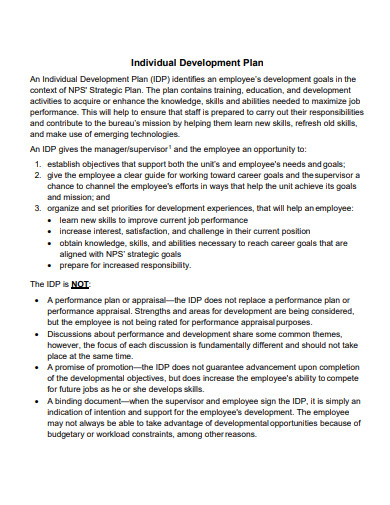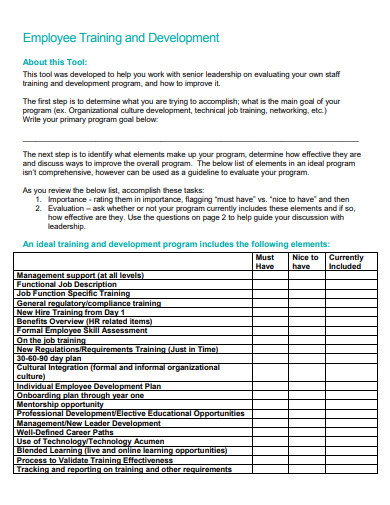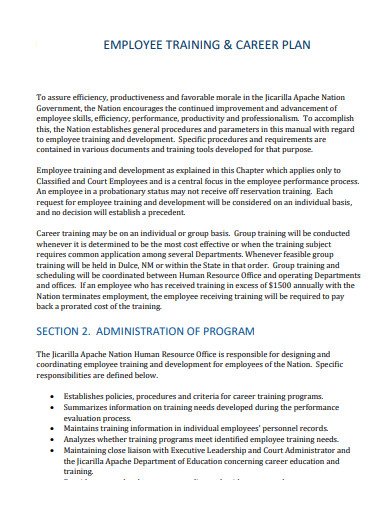Employee training is part of a company’s human resources department to organize and conduct frequently to ensure the efficiency of their employees’ performance in their various jobs in the company or the organization. Training may vary according to the company’s priorities in their goals in a particular year or if they need to address some concerns regarding the operations of the entire staff or their performances. One way to improve every staff’s productivity positively is to provide an individual training plan that caters to their level of areas where they are good at and at areas where they need to improve. This would address all concerns directly and even see an effective result when those things are addressed properly. This article will guide you on how to make an individual employee training plan.
3+ Individual Employee Training Plan Samples
1. Individual Employee Training Plan

2. Individual Employee Training and Development Plan
3. Sample Individual Employee Training Plan
4. Individual Employee Training and Career Plan
What is a Training Plan?
A training plan also called a learning session plan, is a written document with an organized description of the activities and resources included that trainers use to guide a group of people or an individual toward a specific learning objective.
How to Write an Individual Employee Training Plan
1. Identify Your Goals
Managers and HR professionals frequently overlook the critical duty of establishing and expressing the exact aim when developing a new employee training plan. They may set broad, ambiguous, or even unspoken objectives, such as “we want wiser and better staff,” but this does not immediately benefit the organization or indicate the training’s purpose. You might begin by determining the company’s goals. Knowing the business objectives can help you shape the training aim, whether it’s to boost productivity, improve sales conversion rates, or cut costs. You provide your staff with more direction and understanding from the start when you specify the particular purpose of your training program.
2. Prepare for the Training
Now that you and your team know where all of these efforts are going, you can start creating training materials and putting together a plan. Consider what your training will entail, the software you’ll use, and the timetable you’ll follow during this process. Will employees be trained for an hour a day or two days? When creating corporate digital learning courses, it’s important to be meticulous and patient, since adequate planning will make your training go as smoothly as possible. Employees, on the other hand, do not want to feel as if their time is being wasted on rushed, ill-prepared training.
3. Develop the Training Courses
You can begin developing your employee training plan now that you have the goals and outlines for the training materials. This is the stage in which you start designing the courses and learning routes that will assist your students to gain knowledge and skills. If you’re having problems coming up with an online training plan, you might want to consider hiring a consultant. Companies that specialize in designing staff training plan templates and developing resources such as posters, cards, and even movies exist. With their help, you can develop high-quality tools that will boost employee engagement. Additionally, pre-made courses might help you save both time and money.
4. Discuss the Training Activities With Your Employees
Within the centralized training programs, resources and tools that are standardized by worldwide requirements can be used. When you get down to the level of single people, you have to remember that you’ll need to agree on a specific set of activities and select appropriate technologies to facilitate the process.
5. State the Responsibilities of the Employee
When it comes to responsibility, you must be very particular with customized training programs. Do you allow each employee to complete a self-evaluation? Do you want to assign a supervisor or a team, or do you want to encourage them to draft their implementation plans and provide guidance? While new units may need to be formed, the entire process must be transparent.
6. Set Your Terms and Expectations
To deal with the lack of a standardized procedure, you’ll need to develop a specific set of analytics and evaluation tools.
FAQs
What are the five areas of personal development?
The five major areas of personal development are mental, social, spiritual, emotional, and physical.
What are the advantages of an individual employee training plan?
There are a lot of advantages of creating a training plan for employees. Some of these are:
- It fosters individuality: The training plan includes tactics and strategies that enhance everyone’s unique skills, traits, and abilities. The training plan can also develop the creativity of each individual by providing activities that will challenge them.
- It provides personal development: The training plan has other strategies that also address the employees’ personal goals. They have trained accordingly with their position in the company and can be trained with additional skills needed for promotion.
- It fosters loyalty: When the company supports their staff and helps them bring closure to their goals through the training plan, it can create a positive environment mutually beneficial for both parties.
Since you will be training your employees individually and catering the training plan to their unique skills and characteristics to make their training more effective, you’ll have to treat each scenario separately and compare performance changes based on your evaluation through the use of performance indicators and statistics. To help you get started making the contract, download our free sample templates above to use as your guide!
Related Posts
FREE 7+ Fashion Business Plan Samples in PDF
FREE 10+ Sprint Planning Samples In MS Word | Google Docs | PDF
FREE 10+ Wedding Planning Samples in MS Word | Apple Pages | Powerpoint | PDF
FREE 9+ Monthly Study Planner Samples in PSD | Illustrator | InDesign | PDF
FREE 9+ Sample Curriculum Planning Templates in PDF | MS Word
FREE 10+ Teacher Development Plan Samples in MS Word | Google Docs | Apple Pages | PDF
FREE 10+ Basketball Practice Plan Samples in PDF
FREE 12+ School Business Plan Samples in PDF | MS Word | Apple Pages | Google Docs
FREE 7+ Client Strategic Plan Samples in PDF | MS Word
FREE 11+ Trucking Business Plan Templates in PDF | MS Word | Google Docs | Pages
FREE 7+ Small Hotel Business Plan Samples PDF | MS Word | Apple Pages | Google Docs
FREE 14+ Bakery Business Plans in MS Word | PDF | Google Docs | Pages
FREE 4+ Yearly Lesson Plan Samples in PDF
FREE 50+ Strategic Planning Samples in Google Docs | Pages | PDF | MS Word
FREE 10+ Construction Project Plan Samples in MS Word | Google Docs | Apple Pages | PDF



